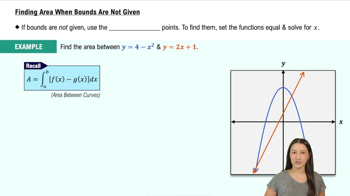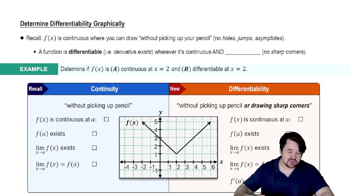Evaluate ∫₃⁸ ƒ ′(t) dt , where ƒ ′ is continuous on [3, 8], ƒ(3) = 4, and ƒ(8) = 20 .
Table of contents
- 0. Functions7h 54m
- Introduction to Functions16m
- Piecewise Functions10m
- Properties of Functions9m
- Common Functions1h 8m
- Transformations5m
- Combining Functions27m
- Exponent rules32m
- Exponential Functions28m
- Logarithmic Functions24m
- Properties of Logarithms36m
- Exponential & Logarithmic Equations35m
- Introduction to Trigonometric Functions38m
- Graphs of Trigonometric Functions44m
- Trigonometric Identities47m
- Inverse Trigonometric Functions48m
- 1. Limits and Continuity2h 2m
- 2. Intro to Derivatives1h 33m
- 3. Techniques of Differentiation3h 18m
- 4. Applications of Derivatives2h 38m
- 5. Graphical Applications of Derivatives6h 2m
- 6. Derivatives of Inverse, Exponential, & Logarithmic Functions2h 37m
- 7. Antiderivatives & Indefinite Integrals1h 26m
- 8. Definite Integrals4h 44m
- 9. Graphical Applications of Integrals2h 27m
- 10. Physics Applications of Integrals 3h 16m
- 11. Integrals of Inverse, Exponential, & Logarithmic Functions2h 34m
- 12. Techniques of Integration7h 41m
- 13. Intro to Differential Equations2h 55m
- 14. Sequences & Series5h 36m
- 15. Power Series2h 19m
- 16. Parametric Equations & Polar Coordinates7h 58m
8. Definite Integrals
Fundamental Theorem of Calculus
Problem 5.3.96c
Textbook Question
Working with area functions Consider the function ƒ and the points a, b, and c.
(c) Evaluate A(b) and A(c). Interpret the results using the graphs of part (b) .
ƒ(𝓍) = ― 12𝓍 (𝓍―1) (𝓍― 2) ; a = 0 , b = 1 , c = 2
 Verified step by step guidance
Verified step by step guidance1
Step 1: Understand the problem. The function ƒ(𝓍) = -12𝓍(𝓍 - 1)(𝓍 - 2) is given, and we are tasked with evaluating A(b) and A(c), where A(x) represents the area under the curve of ƒ(𝓍) from a = 0 to x. This involves calculating definite integrals of ƒ(𝓍) over the intervals [0, b] and [0, c].
Step 2: Set up the integral for A(b). To find A(b), compute the definite integral of ƒ(𝓍) from 0 to b. The integral expression is: .
Step 3: Set up the integral for A(c). Similarly, to find A(c), compute the definite integral of ƒ(𝓍) from 0 to c. The integral expression is: .
Step 4: Interpret the results graphically. The values of A(b) and A(c) represent the signed areas under the curve of ƒ(𝓍) from x = 0 to x = b and x = 0 to x = c, respectively. Positive areas correspond to regions above the x-axis, while negative areas correspond to regions below the x-axis. Use the graph of ƒ(𝓍) to visualize these areas.
Step 5: Solve the integrals. To evaluate A(b) and A(c), expand the polynomial -12𝓍(𝓍 - 1)(𝓍 - 2), integrate term by term, and apply the limits of integration. This step involves algebraic manipulation and the fundamental theorem of calculus.
 Verified video answer for a similar problem:
Verified video answer for a similar problem:This video solution was recommended by our tutors as helpful for the problem above
Video duration:
4mPlay a video:
Was this helpful?
Key Concepts
Here are the essential concepts you must grasp in order to answer the question correctly.
Area Function
An area function, often denoted as A(x), represents the accumulated area under a curve from a starting point to a variable endpoint x. In this context, A(b) and A(c) will provide the total area under the curve of the function ƒ(x) from the point a to points b and c, respectively. Understanding how to compute and interpret these areas is crucial for analyzing the behavior of the function over specified intervals.
Recommended video:

Finding Area When Bounds Are Not Given
Definite Integral
The definite integral of a function over an interval gives the net area between the function and the x-axis within that interval. It is calculated using the Fundamental Theorem of Calculus, which connects differentiation and integration. Evaluating A(b) and A(c) involves computing the definite integral of ƒ(x) from a to b and from a to c, respectively, which quantifies the area under the curve for those segments.
Recommended video:

Definition of the Definite Integral
Graphical Interpretation
Graphical interpretation involves analyzing the visual representation of a function to understand its behavior and the significance of calculated areas. By examining the graphs from part (b), one can see how the areas A(b) and A(c) correspond to the regions under the curve of ƒ(x) between the specified points. This helps in understanding the relationship between the algebraic results of the area function and their geometric implications.
Recommended video:

Determining Differentiability Graphically

 6:11m
6:11mWatch next
Master Fundamental Theorem of Calculus Part 1 with a bite sized video explanation from Patrick
Start learningRelated Videos
Related Practice
Textbook Question
12
views
